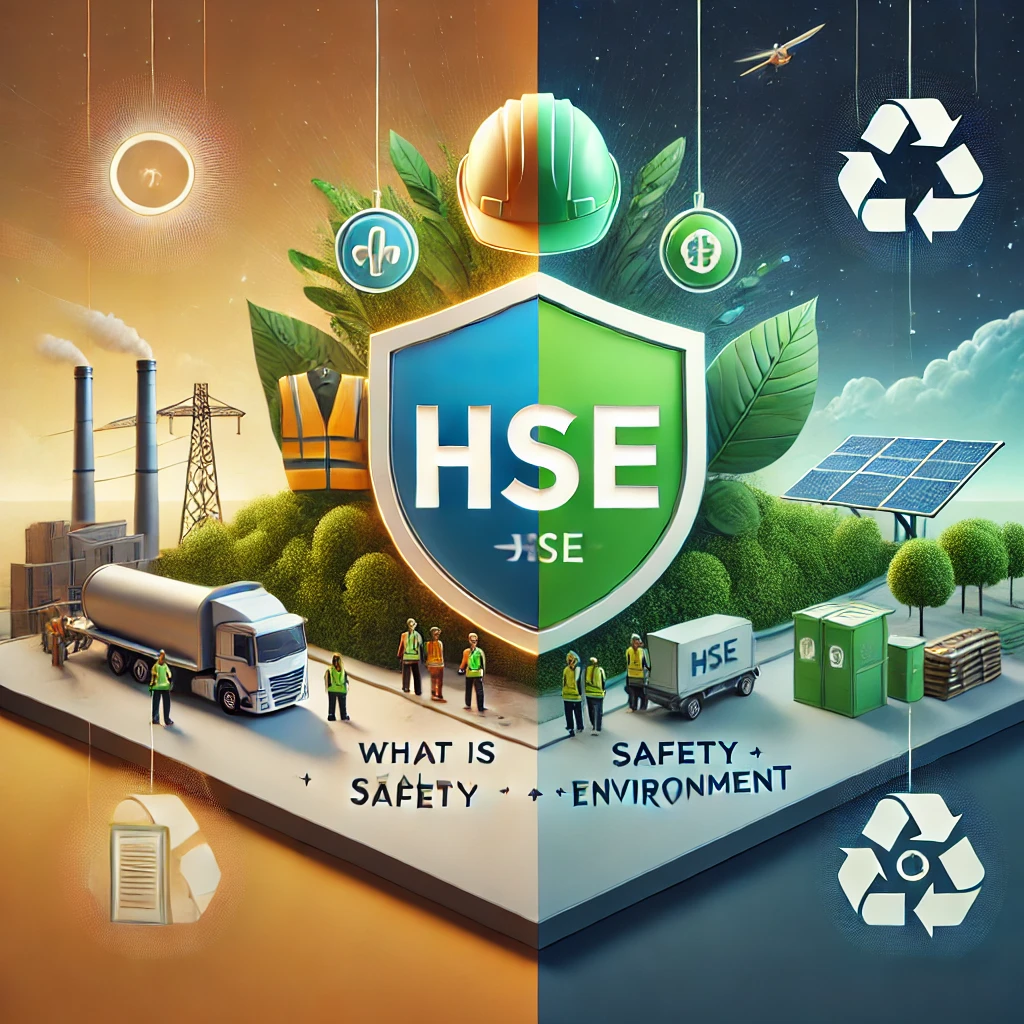
Introduction of HSE (Health, Safety, and Environment)
1. Introduction
Health, Safety, and Environment (HSE) is a critical discipline that focuses on protecting the well-being of employees, the public, and the environment in workplaces and communities. HSE encompasses policies, procedures, and regulations designed to minimize risks, prevent accidents, and ensure sustainable practices.
Importance of HSE
Protecting Human Health
Workplace hazards such as chemical exposure, ergonomic risks, and psychological stress can lead to long-term health issues. HSE programs aim to:
- Identify health risks (e.g., respiratory diseases from dust or fumes).
- Implement control measures (e.g., ventilation systems, personal protective equipment (PPE)).
- Promote employee wellness programs (e.g., mental health support, regular medical check-ups).
Ensuring Workplace Safety
Safety measures prevent accidents such as falls, machinery-related injuries, fires, and explosions. Key aspects include:
- Conducting risk assessments.
- Training employees on safety protocols.
- Implementing emergency response plans.
Environmental Protection
Industries contribute to pollution, deforestation, and climate change. HSE helps in:
- Reducing carbon emissions and waste.
- Ensuring proper disposal of hazardous materials.
- Complying with environmental laws (e.g., EPA, REACH, ISO 14001).
Legal and Financial Benefits
Non-compliance with HSE regulations can result in legal penalties, reputational damage, and financial losses. Effective HSE management:
- Reduces workplace injuries, lowering compensation costs.
- Enhances corporate reputation and stakeholder trust.
- Improves operational efficiency by minimizing downtime.
Example:
In the oil and gas industry, an HSE policy may include measures like regular equipment inspections, emergency response drills, and proper waste disposal to prevent spills and protect workers.
2. Key Components of HSE
Occupational Health
Occupational health focuses on preventing work-related diseases through:
- Hazard Identification: Recognizing chemical, physical, and biological risks.
- Exposure Monitoring: Measuring air quality, noise levels, and radiation.
- Medical Surveillance: Regular health check-ups for high-risk workers.
Workplace Safety
Safety management involves:
- Risk Assessments: Identifying potential hazards (e.g., slippery floors, electrical faults).
- Safety Training: Educating employees on proper equipment use and emergency procedures.
- Incident Reporting: Documenting accidents to prevent recurrence.
Environmental Management
Environmental protection strategies include:
- Waste Management: Recycling, reducing landfill waste.
- Pollution Control: Treating emissions and effluents before release.
- Sustainable Practices: Using renewable energy, eco-friendly materials.
HSE Policies and Regulations
Governments and international bodies enforce HSE standards, such as:
- OSHA (Occupational Safety and Health Administration) – U.S. workplace safety laws.
- ISO 45001 – Global standard for occupational health and safety.
- EPA (Environmental Protection Agency) – Regulates environmental compliance.

3. HSE Implementation Strategies
HSE Management Systems (HSEMS)
An HSEMS provides a structured approach to managing risks. Key steps include:
- Planning: Setting HSE objectives and policies.
- Implementation: Training, hazard controls, and emergency preparedness.
- Monitoring: Regular audits and inspections.
- Review: Continuous improvement based on incident reports.
Risk Assessment and Mitigation
- Hazard Identification: Using checklists, job safety analysis (JSA).
- Risk Evaluation: Determining severity and likelihood of hazards.
- Control Measures: Hierarchy of controls (Elimination, Substitution, Engineering Controls, Administrative Controls, PPE).
Employee Training and Awareness
- Induction Training: New employees learn workplace hazards.
- Toolbox Talks: Short safety meetings on specific risks.
- Certification Programs: OSHA 30, NEBOSH, IOSH courses.
Emergency Preparedness
Fire Drills: Evacuation procedures.
First Aid Training: CPR, wound treatment.
Spill Response: Handling chemical leaks.
4. Challenges in HSE Management
Compliance with Changing Regulations
Laws evolve, requiring companies to update policies frequently.
Behavioral Safety
Employees may ignore protocols due to complacency or lack of awareness.
Cost of Implementation
Small businesses may struggle with expensive safety equipment and training.
5. Benefits of HSE Implementation
- Reduced Accidents & Fatalities
- Improved Employee Morale & Productivity
- Legal & Regulatory Compliance
- Enhanced Corporate Reputation
- Cost Savings (Fewer lawsuits, lower insurance premiums)
Example:
A manufacturing plant that implements strict HSE policies may see a 50% reduction in workplace injuries, leading to lower compensation costs.
5. Challenges in HSE Implementation
- High Initial Costs (Training, equipment, audits)
- Employee Resistance to Change
- Keeping Up with Regulatory Changes
- Balancing Productivity & Safety
Example:
A mining company may struggle with enforcing safety helmets among workers who find them uncomfortable, requiring continuous training.
6. Conclusion
HSE is essential for safeguarding human lives, ensuring legal compliance, and protecting the environment. Organizations that prioritize HSE benefit from fewer accidents, better employee satisfaction, and long-term sustainability. By integrating robust HSE policies, companies can create safer workplaces while contributing to environmental conservation.
Near-Miss vs Accident vs Incident
Unsafe Act vs Unsafe Condition: Key Differences with Industry Examples
HSE vs EHS vs SHE: Difference Between HSE, EHS, and SHE – A Detailed Comparison
7. FAQs
1. What is HSE?
Answer:
HSE stands for Health, Safety, and Environment, a systematic approach to managing risks and compliance in workplaces to ensure employee well-being, workplace safety, and environmental protection. It involves policies, procedures, and training to prevent accidents, injuries, illnesses, and environmental harm.
Key Components:
- Health: Protecting workers from occupational diseases (e.g., exposure to chemicals, ergonomic risks).
- Safety: Preventing workplace accidents (e.g., slips, falls, machinery hazards).
- Environment: Minimizing ecological impact (e.g., waste management, pollution control).
2. Why is HSE Important?
Answer:
HSE is crucial because:
- Legal Compliance: Avoid fines and legal penalties by following regulations (e.g., OSHA, EPA, ISO 45001).
- Employee Protection: Reduces workplace injuries, illnesses, and fatalities.
- Cost Savings: Lowers medical expenses, insurance premiums, and compensation claims.
- Reputation: Enhances corporate image and stakeholder trust.
- Sustainability: Ensures eco-friendly operations for long-term business viability.
3. What Are the Key HSE Regulations?
Answer:
Major HSE regulations vary by country but include:
- Occupational Safety and Health Administration (OSHA) – U.S. workplace safety laws.
- Environmental Protection Agency (EPA) – U.S. environmental regulations.
- European Agency for Safety and Health at Work (EU-OSHA) – EU standards.
- ISO 45001 (Occupational Health & Safety) – Global safety management standard.
- ISO 14001 (Environmental Management) – Global environmental standards.
4. What Are the Core Elements of an HSE Management System?
Answer:
An effective HSE management system includes:
- Risk Assessment: Identifying workplace hazards.
- Policies & Procedures: Clear safety guidelines.
- Training & Awareness: Employee education on HSE practices.
- Emergency Preparedness: Fire drills, spill response plans.
- Incident Reporting & Investigation: Tracking accidents to prevent recurrence.
- Audits & Inspections: Regular checks for compliance.
- Continuous Improvement: Updating policies based on new risks.
5. What Are Common Workplace Hazards Addressed by HSE?
Answer:
HSE mitigates hazards such as:
- Physical Hazards: Noise, radiation, extreme temperatures.
- Chemical Hazards: Toxic fumes, flammable materials.
- Biological Hazards: Bacteria, viruses (e.g., in healthcare).
- Ergonomic Hazards: Poor posture, repetitive strain injuries.
- Environmental Hazards: Air/water pollution, waste disposal.
6. How Does HSE Benefit Employees?
Answer:
Employees gain:
- Safer Work Environment: Fewer accidents and injuries.
- Health Monitoring: Regular check-ups and PPE (Personal Protective Equipment).
- Job Security: Companies with strong HSE records have fewer disruptions.
- Mental Well-being: Reduced stress from unsafe conditions.
7. What Is the Role of an HSE Officer?
Answer:
An HSE Officer ensures compliance by:
- Conducting risk assessments.
- Implementing safety protocols.
- Training employees.
- Investigating incidents.
- Ensuring environmental regulations are followed.
8. How Can Companies Improve HSE Performance?
Answer:
Improvement strategies include:
- Leadership Commitment: Management must prioritize HSE.
- Employee Involvement: Workers should report hazards.
- Technology Use: Wearables for monitoring, AI for risk prediction.
- Regular Audits: Identifying gaps in safety measures.
- Benchmarking: Comparing HSE performance with industry standards.
9. What Is the Difference Between HSE, EHS, and SHE?
Answer:
- HSE: Health, Safety, Environment (prioritizes health first).
- EHS: Environment, Health, Safety (emphasizes environmental impact).
- SHE: Safety, Health, Environment (focuses on safety first).
The order varies, but all cover the same three areas.
10. How Does HSE Relate to Corporate Social Responsibility (CSR)?
Answer:
HSE aligns with CSR by:
Meeting sustainability goals (e.g., zero waste, renewable energy).
Ensuring ethical treatment of workers.
Reducing environmental damage (e.g., carbon footprint).
Enhancing community relations through safe operations.























